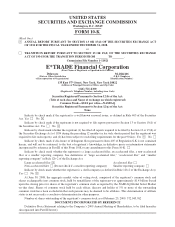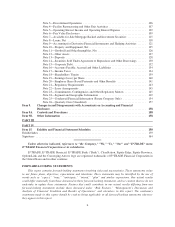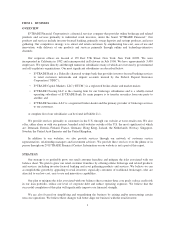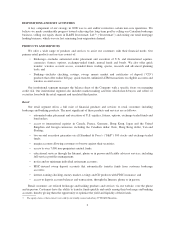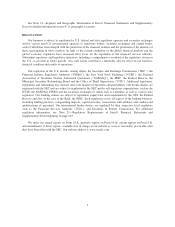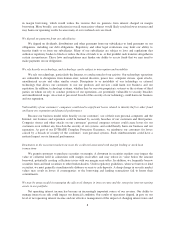eTrade 2008 Annual Report Download - page 11
Download and view the complete annual report
Please find page 11 of the 2008 eTrade annual report below. You can navigate through the pages in the report by either clicking on the pages listed below, or by using the keyword search tool below to find specific information within the annual report.in margin borrowing, which would reduce the revenue that we generate from interest charged on margin
borrowing. More broadly, any reduction in overall transaction volumes would likely result in lower revenues and
may harm our operating results because many of our overhead costs are fixed.
We depend on payments from our subsidiaries
We depend on dividends, distributions and other payments from our subsidiaries to fund payments on our
obligations, including our debt obligations. Regulatory and other legal restrictions may limit our ability to
transfer funds to or from our subsidiaries. Many of our subsidiaries are subject to laws and regulations that
authorize regulatory bodies to block or reduce the flow of funds to us, or that prohibit such transfers altogether in
certain circumstances. These laws and regulations may hinder our ability to access funds that we may need to
make payments on our obligations.
We rely heavily on technology, and technology can be subject to interruption and instability
We rely on technology, particularly the Internet, to conduct much of our activity. Our technology operations
are vulnerable to disruptions from human error, natural disasters, power loss, computer viruses, spam attacks,
unauthorized access and other similar events. Disruptions to or instability of our technology or external
technology that allows our customers to use our products and services could harm our business and our
reputation. In addition, technology systems, whether they be our own proprietary systems or the systems of third
parties on whom we rely to conduct portions of our operations, are potentially vulnerable to security breaches
and unauthorized usage. An actual or perceived breach of the security of our technology could harm our business
and our reputation.
Vulnerability of our customers’ computers could lead to significant losses related to identity theft or other fraud
and harm our reputation and financial performance
Because our business model relies heavily on our customers’ use of their own personal computers and the
Internet, our business and reputation could be harmed by security breaches of our customers and third parties.
Computer viruses and other attacks on our customers’ personal computer systems could create losses for our
customers even without any breach in the security of our systems, and could thereby harm our business and our
reputation. As part of our E*TRADE Complete Protection Guarantee, we reimburse our customers for losses
caused by a breach of security of the customers’ own personal systems. Such reimbursements could have a
material impact on our financial performance.
Downturns in the securities markets increase the credit risk associated with margin lending or stock loan
transactions
We permit customers to purchase securities on margin. A downturn in securities markets may impact the
value of collateral held in connection with margin receivables and may reduce its value below the amount
borrowed, potentially creating collections issues with our margin receivables. In addition, we frequently borrow
securities from and lend securities to other broker-dealers. Under regulatory guidelines, when we borrow or lend
securities, we must generally simultaneously disburse or receive cash deposits. A sharp change in security market
values may result in losses if counterparties to the borrowing and lending transactions fail to honor their
commitments.
We may be unsuccessful in managing the effects of changes in interest rates and the enterprise interest-earning
assets in our portfolio
Net operating interest income has become an increasingly important source of our revenue. Our ability to
manage interest rate risk could impact our financial condition. Our results of operations depend, in part, on our
level of net operating interest income and our effective management of the impact of changing interest rates and
8

